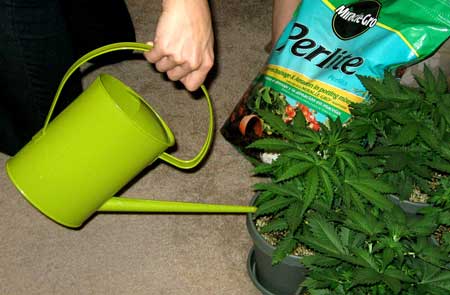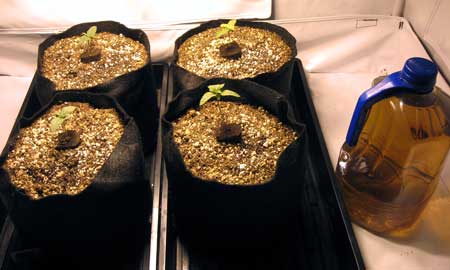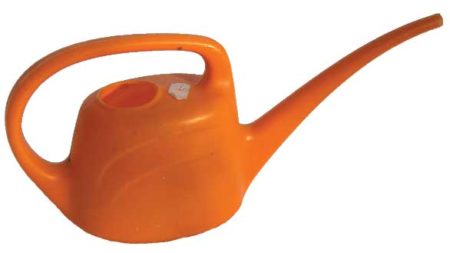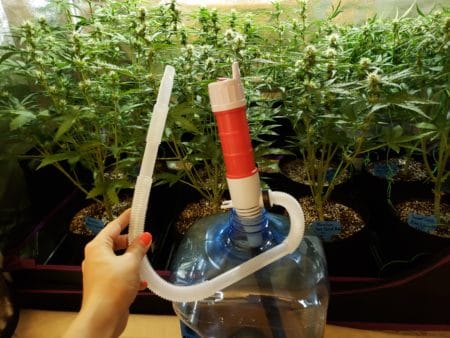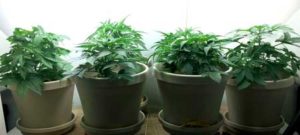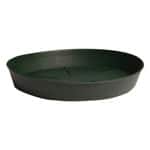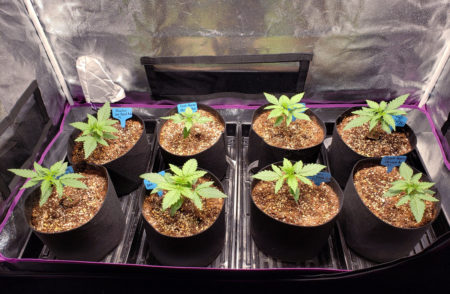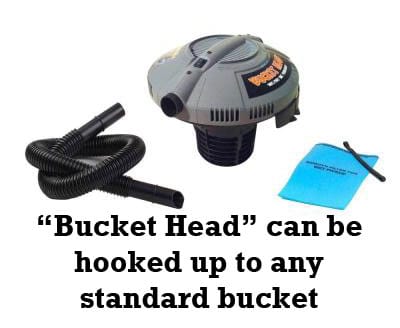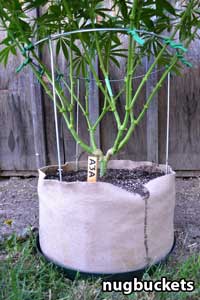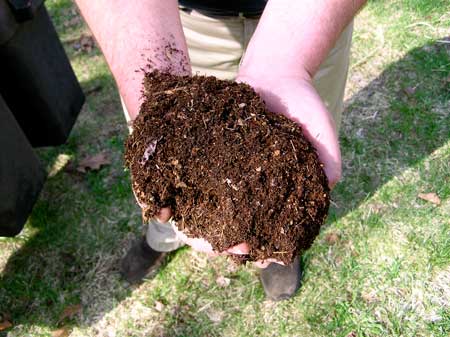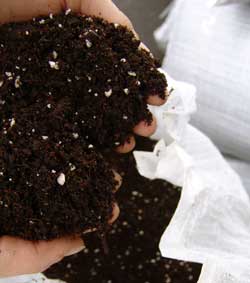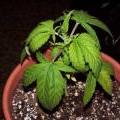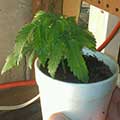by Nebula Haze
If you’re growing marijuana in soil or another growing medium like coco coir, you will have to hand-water your plants. Watering is an important part of growing cannabis indoors, and knowing how to water your plants will save you a lot of frustration!
How often do you give your cannabis water?
Well, you will want to water your marijuana whenever the top of the soil or growing medium starts to feel dry. I like to water when the medium feel dry up to my first knuckle, or about an inch.
- Soil – Water plants when the soil feels dry up to your first knuckle (or if the pot feels light).
- Coco Coir – Aim to water plants every 1-2 days. If coco is staying wet for 3+ days, try giving less water at a time until plants get bigger and start drinking more. Don’t wait for your coco coir to dry out, but don’t water if the top inch feels “wet”. If the container feels light, it’s definitely time to water!
How to water cannabis properly (when using a well-draining potting mixture with liquid nutrients)…
In soil, wait until the topsoil feels dry about an inch deep (up to your first knuckle – just use your finger to poke a hole in the soil and see if it feels dry).
In coco coir, you want to water every 1-2 days if possible and adjust the amount of water you give accordingly. The top inch doesn’t need to completely dry out between waterings.
If you’re regularly adding nutrients in the water, give enough water each time that you get 10-20% extra runoff water drain out the bottom of your pot. This prevents a buildup in the potting mixture because otherwise, you are continuously adding more nutrients to the system.
Go back to step 1. Note: If water takes a long time to come out the bottom, or if pots take longer than 5 days to dry out before the next watering, you may actually have a problem with drainage (more info below) or need to give less water at a time. If your plants are very small compared to the container they’re in, give water more sparingly until plants get bigger.
Growing in Super Soil?
- If you’re growing in super soil or another heavily amended potting mix, you may not need to add extra nutrients to the water because your plants can get all their nutrients directly from the soil.
- Any time you’re not adding extra nutrients in the water, you want to avoid getting runoff water because it will carry away some of the nutrients in the soil.
- Watering until you get runoff is important when using liquid nutrients because it helps prevent nutrient build up, but with super soil try to give just enough water that you wet the entire medium but don’t get extra water coming out the bottom.
Some growers swear by the “lift the pot” method to decide when to water your plants (basically wait until your pot feels “light” since the plants have used up all the water). It’s up to you to decide what’s easier for you.
I usually water my cannabis with a 1-gallon water jug for small grows, or 5-gallon jugs for larger ones. Runoff water is collected in the trays and after a few minutes I suck it all up with a small wet vac.
How to Provide the Water
When I first started growing, I gave my plants water using a watering can. A watering can works great, but it’s hard to water a bunch of plants with one watering can because you have to keep filling it up.
An old-fashioned watering can will get the job done, but they typically don’t hold a lot of water at a time, which is inconvenient if you’re growing a lot of plants
I personally like using a Battery Operated Liquid Transfer Pump to water the plants. You can pump water from a bigger container to your plants. This is a 3-gallon water container from Wal-Mart, and the pump just reaches the bottom.
My grow tent is 2 feet deep and this reaches the plants in the back. However, I don’t think the tube is long enough to reach the back if your space is deeper than that.
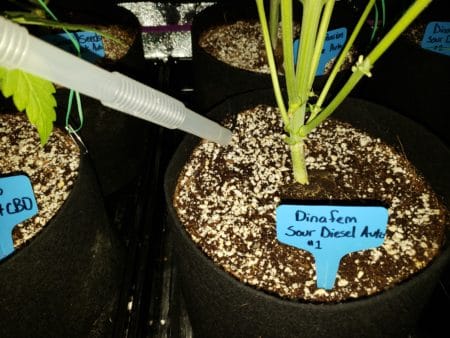
Let us know if there’s something we missed. Growers get creative!
How to Collect Runoff Water
It’s important to keep plants on saucers or trays so you can remove the runoff water. You can collect the saucers one by one and dump them out, but that also gets inconvenient with many plants.
It’s inconvenient to empty saucers one by one if you have a bunch of plants, but you don’t want to leave plants sitting in runoff water
If you put your plant on plastic trays, and then put the trays on a slight incline by putting something small underneath in the back, it will catch all the runoff water and cause it to drain to the front. The item in the back only needs to be about half an inch thick, for example a piece of plywood. However, if you can find something more water-resistant, like plastic, that’s even better.
These 1’x2′ plastic plant trays work well if they fit your space. You can fit four of them in a 2’x4′ grow tent (this is the grow tent I use) with up to two plants each as long as your plant containers are 11″ wide or smaller at the base.
Put trays on a slight incline by placing something underneath the tray in the back. This causes all the water to come to the front for easier collection. Each of these trays has a small plastic board (which we found around the house from something else) under the back. Anything that’s about half an inch high will do the trick. These particular trays accommodate plant containers up to 11″ wide at the base.
Not sure how to remove runoff water after watering your marijuana? Wet vacuums can be a great choice, especially if you already have one in the house. I didn’t have one, so I got Bucket Head attachment which can turn any standard 5-gallon bucket into a wet vac. You can buy one online but it’s $10-15 cheaper if you get it in person at a Home Depot. Another similar option is the Power Lid, though it’s also a bit pricey.
A downside to the Bucket Head is it’s a little loud, just like most wet vacs. Luckily you only need to use it for a few minutes after watering your plants!
Removing runoff water is a great start to make sure you are watering your cannabis plants perfectly, but it’s also important to…
Make Sure Pots Have Good Drainage
It’s very important to make sure that water can drain freely from the bottom of the pot, otherwise, the plant can get waterlogged and become overwatered (causing the plant to droop).
In addition to making sure the actual container has drainage (holes on the bottom, or some other way for extra water to escape), it’s also important to make sure your growing medium drains freely. If it takes several minutes for the water to come out the bottom of your pot when you water, it means that there isn’t enough drainage in the actual growing medium (it’s too dense, so water is having a hard time getting through).
How to improve the drainage of your growing medium
- Never use dirt you find outside. Chances are it does not have the correct properties for vigorous cannabis growth.
- Mix in extra perlite to loosen the soil and allow water to drain through more easily.
- Bark or wood chips are not the best choice for growing cannabis plants, even though they’re sometimes recommended to improve drainage in soil for some types of plants. On that note, avoid using soil that contains bark or wood chips. What makes soil good or bad for growing cannabis?
- Use Smart pots – these fabric pots help get oxygen to your roots (which gives you faster growth) and this type of pot makes it harder to overwater your plants. A cannabis plant growing in a tan fabric smart pot is pictured to the right.
This is an example of great soil for growing for cannabis – rich, composted, and well-draining
Composted super soil lets you grow organic marijuana without any extra fertilizers or nutrients
Watering Too Often? Barely at All?
In the beginning of your grow, you will likely be watering your marijuana plants every couple of days. Watering every 2-3 days is optimal for a young plant. If it’s taking too long for your plant to dry out, you may need to give less water at a time until the plant is growing faster.
If you feel like you are watering your plants too often, you may need to give more water at a time. You can also move plants into a bigger pot (which holds water for longer).
If plants take longer than 3-4 days to dry, make sure your potting mixture has good drainage and consider giving less water at a time
If plants are drying out in 1 day or less, try giving more water at a time or transplanting to a bigger pot
Speaking of pot size, it is generally best to start young cannabis plants in relatively small containers (like a solo cup with a few holes cut out of the bottom for drainage), and move plants into bigger containers as they get bigger. Starting in smaller containers makes it a lot harder to overwater your plants when they’re young, and makes it easier to flush plants and/or respond to problems if they occur.
That being said, you can plant your seeds right into their final container. Just be careful not to overwater your seedlings at first if they’re in a big container as they’re not drinking much water in the beginning.
More help with watering cannabis seedlings
If you started your plants in a solo cup, I’d recommend moving to a bigger pot once the plant is a week or two old, as soon as the leaves reach the edges of the solo cup.
10-20% Extra Runoff Every Time You Water (if you’re providing nutrients in the water)
Every time you water your plants, make sure that you provide enough water to get about 10-20% extra run-off out the bottom of the container, especially if you’re feeding additional nutrients in the water.
Sometimes soil and soilless growing mediums like coco coir start to collect natural salts from fertilizers that never get washed out.
These built-up salts can eventually cause nutrient problems, pH problems, and nutrient lock-out if they’re not removed on a regular basis.
Making sure you keep adding water until you get run-off is also a great way to make sure that your plants are draining properly.
Plus, this practice will immediately alert you to any drainage problems, (as mentioned earlier, cannabis likes well-draining soil) because you’ll be able to notice if the water takes a long time to come out the bottom, or doesn’t come out at all.
Different Nutrients for Different Stages of Life
First, make sure you’re using proper cannabis nutrients for your growing medium. They should be formulated for a plant like tomatoes, and they should have a different feeding schedule for the Vegetative (Grow) and Flowering (Bloom) stage.
If using nutrients on a regular basis by adding them to your water, it’s generally a good idea to give your cannabis plants nutrients every watering. This ensures the amount of nutrients in the plant root zone is kept relatively stable. If you notice the tips of leaves getting burnt from nutrient burn, it may mean you need to lower your overall strength of nutrients. Most nutrient recommendations on the side of the bottle are too strong for cannabis plants, and should be cut in half unless plants appear pale or lime green (which means they want higher levels of nutrients overall).
If Growing in Composted or Amended Soil, Give Just Enough Water That the Soil is Wet All the Way Through
When growing in composted and amended soil, the soil itself is made to slowly provide nutrients to your plant throughout its life. However, if you’re regularly watering until you get a significant amount of runoff, you’ll also be washing away some of your nutrients.
This is good when the plant is getting the nutrients directly in the water, to avoid unwanted buildup in the soil, but try to avoid a lot of extra runoff if you want your nutrients in the container to last until harvest.
Therefore, when growing in amended soil you should only water until you get just a drop or two of water runoff out the bottom. You want to ensure you gave enough water to reach the bottom of the pot without letting a significant amount of water run out the bottom.
Learn more about growing in composted and amended soil (just add water!)
Proper watering practices will greatly help reduce the amount of salt buildup and prevent nutrition problems from occurring.
Drooping Plants?
If your cannabis plants shows signs of drooping, often the plant is getting too much or too little water, but not always. Drooping can be caused by….
- Too much water at a time, or giving water too often
- Not enough water at a time, or giving water too infrequently
- Drooping can also occur in hot conditions, or when it’s very humid or dry because the plant isn’t able to move water properly through the plant.
- Plants sometimes get droopy if they are given a lot of water after being allowed to dry out for too long, due to the stress of the water pressure quickly changing at the roots.
- Drooping is almost always associated with something going on at the roots, but plants also tend to put their leaves down a bit right before the lights go off, as if they’re preparing to “sleep” for the night. That can sometimes be mistaken as drooping when its actually part of the plant’s natural rhythm.
In order to prevent over or under-watering, make sure you water thoroughly every time (don’t just water a tiny spot in the middle of the pot unless you plant is very small for the container). You should be getting 10-20% extra runoff water every time if you’re adding nutrients in the water. In soil, wait to water again until the top inch of the growing medium feels dry, up to your first knuckle or so. In coco coir, aim to water the plants every 1-3 days if possible, and don’t let the top completely dry out between waterings.
Underwatered Marijuana Plants
- Wilting is the first sign of underwaterd marijuana plants
- Leaves are limp and lifeless, they may seem dry or even “crispy”
- Will eventually lead to plant death if not corrected
Learn more about underwatering
Overwatered Marijuana Plants
- Drooping / Curling is the first sign of overwaterd marijuana plants
- Leaves are firm and curled down all the way from the stem to the leaf
- Will eventually lead to leaf yellowing and other signs of nutrient problems if not corrected
If your plant is experiencing “the claw” and not just normal drooping (like the ends of leaves are just pointing down like talons, then you may actually have a nitrogen toxicity (too much nitrogen).
Nitrogen Toxicity (“The Claw,” tips bent down, dark leaves)
Learn more about Nitrogen Toxicity
Jump to…
7 Steps to Fix Most Cannabis Growing Problems
What supplies do I need to get started growing indoors?
Where can I safely buy medical cannabis seeds?
Beginner’s guide to growing weed!

